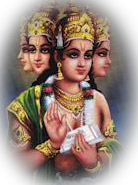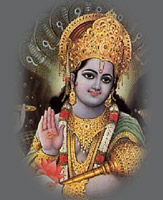|
|

|
|

| Hinduism | Hindu Gods and Goddess | Punniya Grandhas (Sacred Texts) | Sacred Places |
The Trinity
|
The trinity | Vedic Gods | Incarnations of Vishnu | Ganapati | Lakshmi | Parvati | Saraswati | Subrahmanya |
The three gods-Brahma, Vishnu and Siva together form the Hindu Trinity. Brahma creates the world, Vishnu sustains it and Siva destroys it. Hindus are divided into three main groups based on the deity they worship. The worshippers of Siva are known as Saivas, worshippers of Sakti (consort of Siva) as Saktas and worshippers of Vishnu as Vaishnavas. Each of these gods has a consort, and the gods and their consorts have many manifestations. Each god also has a vehicle on which they ride, and a symbol.
Brahma
Brahma, the creator, from the cosmological point of view is the Golden Embryo (Hiranyagarbha), the ball of fire, from which the universe develops.
The icon of
Brah ma has four heads facing the four
quarters and they represent the four Vedas, the four Yugas (epochs of
time), and the four Varnas (divisions of society based on nature, nurture and
vocation). There are four arms holding different objects and in different poses.
The objects usually shown are Aksamala (rosary), Kurca ( a bunch of Kusa grass),
Sruk (ladle), Sruva (spoon), Kamandalu (water pot) and Pustaka (book). The
rosary represents time, and the water pot; the casual water, from which all
creation has sprung. The Kusa grass, the ladle and the spoon being sacrificial
implements, represent the system of sacrifice which means to be adopted by the
various creatures to sustain one another. The book represents knowledge, sacred
and secular. The poses of the hand (Mudras) are Abhaya (assuring protection) and
Varada (granting boons).
ma has four heads facing the four
quarters and they represent the four Vedas, the four Yugas (epochs of
time), and the four Varnas (divisions of society based on nature, nurture and
vocation). There are four arms holding different objects and in different poses.
The objects usually shown are Aksamala (rosary), Kurca ( a bunch of Kusa grass),
Sruk (ladle), Sruva (spoon), Kamandalu (water pot) and Pustaka (book). The
rosary represents time, and the water pot; the casual water, from which all
creation has sprung. The Kusa grass, the ladle and the spoon being sacrificial
implements, represent the system of sacrifice which means to be adopted by the
various creatures to sustain one another. The book represents knowledge, sacred
and secular. The poses of the hand (Mudras) are Abhaya (assuring protection) and
Varada (granting boons).
Saraswati is his consort. She is the goddess of knowledge and music. Hamsa (goose/swan) is his vehicle.
The temples dedicated to Brahma are rare. One of them is at Puskar in Rajasthan.
Vishnu
Vishnu is also known as Mahavishnu,
represents Sattvaguna and is the centripetal force as it were respon sible
for sustenance, protection and maintenance of the created Universe.
Another name of Vishnu is Narayana. Vishnu is always described as
Nialamegahasyana, of a dark blue hue like than of the rain-bearing cloud.The icon of Vishnu has one face and four arms each
one holding
Sankha (conch), Chakra (discus), Gada (mace), Padma
(lotus) and wears a necklace with the famous gem Kaustubha dangling on the lock
of hair Srivatsa, on the left chest. He also wears a garland (of gems or fragrant flowers) Vaijayanti by name. The Sankha represents the five
elements like the earth, water etc; chakra stands for the cosmic mind, Gada
indicates the cosmic intellect and the Padma points to the evolving world. The
curl of hair, Srivatsa, represents all objects of enjoyment, the products of
nature. The gem Kaustubha, resting on it, stands for the enjoyer. The garland
Vaijayanti is symbolical of the subtle elements.
sible
for sustenance, protection and maintenance of the created Universe.
Another name of Vishnu is Narayana. Vishnu is always described as
Nialamegahasyana, of a dark blue hue like than of the rain-bearing cloud.The icon of Vishnu has one face and four arms each
one holding
Sankha (conch), Chakra (discus), Gada (mace), Padma
(lotus) and wears a necklace with the famous gem Kaustubha dangling on the lock
of hair Srivatsa, on the left chest. He also wears a garland (of gems or fragrant flowers) Vaijayanti by name. The Sankha represents the five
elements like the earth, water etc; chakra stands for the cosmic mind, Gada
indicates the cosmic intellect and the Padma points to the evolving world. The
curl of hair, Srivatsa, represents all objects of enjoyment, the products of
nature. The gem Kaustubha, resting on it, stands for the enjoyer. The garland
Vaijayanti is symbolical of the subtle elements.
Vishnu's consort is the beautiful Lakshmi, who came from the sea and is the goddess of wealth, prosperity, honour and love. Vishnu's vehicle is the half man, half-eagle known as the Garuda.
Vishnu is supposed to have 10 incarnations (Dasavatara).
SIVA
Siva, last deity of the Trinity is responsible for
the dissolution of the Universe. Literally, Siva is one in whom the Universe
'sleeps' after destruction before the next cycle of creation.
Iconographically Siva may have two, three, four, eight, ten or even thirty-two hands. Some of the various objects shown in the hands are :Trisula (trident), Chakra (discus), Parasu (battle axe), Damaru (drum), Aksamaba (rosary), Mrga (deer), Pasa (noose), Danda (staff), Pinaka or Ajagava (bow), Khatvanga (magic wand), Pasupata (spear), Padma (lotus), Kapala (skull-cap), Darpana (mirror), Khadga (sword) and soon.
The icon of Siva is never worshipped as the Mulamurti (original, installed in the sanctum sanctorum), but only as an Utsavamurti (the icon used during festivals for taking out in a procession).
Lord Siva is a great master of dance (Nataraja). It is believed that all the 108 modes of dancing known to the treatises on dancing have come from him.
Siva's consort is Parvati (also known as Uma, Sati, Kali and Durga). His vehicle is bull (Nandi). Ganapati and Subrahmanya are his son's.